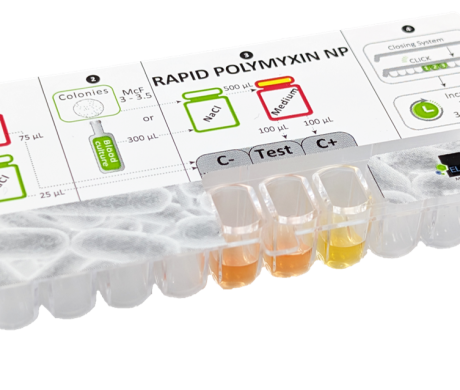Choose your sales office
PRODUCT
Rapid Polymyxin™ NP
Rapid Detection of Resistance to Polymyxins
The Rapid Polymyxin NP test has been designed for the detection of Enterobacteriaceae susceptibility and resistance to polymyxins (Colistin, and polymyxin B) from colonies grown on agar plates or directly from positive blood cultures.
- Fast results in a 2-3 hours from any enterobacterial species
- Reliable approach, regardless of the molecular mechanism of resistance (MCR1 and others)
- Easy to perform, highly specific and sensitive
- Excellent correlation with the reference broth microdilution method in 24h
| Reference | Name | Quantity |
| 23000 | Rapid Polymyxin NP | 10 tests |

Image Gallery
Benefits
Among the most clinically significant multidrug-resistant bacteria are carbapenemase-producing Enterobacteriaceae. Because these bacteria usually remain susceptible to polymyxins, interest in this old class of antibiotics has been recently renewed. However, the increasing use of colistin explains why Enterobacterial strains resistant to colistin are increasingly reported worldwide.
Currently available polymyxins susceptibility methods are fastidious, time-consuming (24 hours) and some methods are not reliable. They are poorly adapted to the clinical need and to the prevention of the dissemination of those multidrug resistant isolates.
ELITechGroup Microbiology proposes a reliable Rapid Polymyxin NP test to detect polymyxins (polymyxin E or Colistin, polymyxin B) resistant Enterobacteriaceae.
This test is based on the detection of the glucose metabolization related to bacterial growth in presence of a defined concentration of colistin. Formation of acid metabolites consecutive to the glucose metabolization is evidenced by a color change (orange to yellow) of a pH indicator.
The Rapid Polymyxin NP test is easy-to-perform, very sensitive and specific. It can detect in only a couple of hours polymyxin-resistant and –susceptible isolates from any enterobacterial species, regardless of the molecular mechanism of polymyxins resistance.
This test offers the possibility of detecting polymyxins resistance from bacterial cultures (colonies and blood cultures) before any antimicrobial drug susceptibility testing results are obtained. Results are obtained at least 16 hours sooner with this test than with the reference broth microdilution method. It is as reliable as the reference dilution technique but much less cumbersome and is not based on diffusion of large polymyxin molecules in agar, which therefore prevents false susceptibility results.
Resistance at 2μg/mL
Procedure
Reagents and material
| Quantity | Description |
|---|---|
| 12 | RP NaCl: Vial of 3mL NaCl solution (0.85 g/L) for inoculum preparation |
| 10 | RP Medium: Vial of 1.5mL culture Medium containing cation-adjusted Mueller Hinton broth (25 g/L), glucose (10 g/L) and phenol red (pH indicator) |
| 10 | RP colistin tray: Tray with a negative control well C-, a Test well with colistin at 2 μg/mL concentration and a bacterial growth control well or positive control well C+. Tray packed in an aluminium sachet with an integrated desiccant. |
| 1 | RP TC (Turbity Control): Vial of 3mL Barium sulphate solution for turbidity control |
| 10 | Closing System: Protective translucent plastic tray lid for the inoculated tray |
Stability and storage
Reagents are ready to use. The kit and its content when stored at +2+8°C in their original state are stable until the expiry date indicated on the box. RP Medium and RP NaCl vials are single-use reagents. The RP TC vial is used as a control for inocula calibration and has to be kept until the last RP Medium vial of the kit has been inoculated. The RP TC reagent has to be stored protected from light and at +2+8°C.
Performance
The evaluation of the performance of the Rapid Polymyxin NP test was conducted in the Emerging Antibiotic Resistance Unit (INSERM, Faculty of Sciences, University of Fribourg, Switzerland), compared with the method for determining the Minimum inhibitory concentration (MIC) in liquid medium (microdilution Mueller-Hinton cation adjusted broth – according to the guidelines of the Clinical Laboratory Standard Institute (3,4) described as the reference method). The bacteria used in this study come from different, international, clinical samples and include the following species:
219 Enterobacteriacae strains were selected as the most representative species of Enterobacteriacae. These include 78 sensitive strains and 141 strains resistant to colistin. Of the resistant strains, different molecular mechanisms of resistance to polymyxins have been observed (chromosomal, plasmidic, intrinsic or unknown). The MICs of the strains and their resistance mechanisms are as follows:
The bacterial strains were reisolated in agar (Luria Bertani, Mueller Hinton, Columbia 5 % blood) for 18 – 24h in order to test the Rapid Polymyxin NP in parallel with the determination of the MIC via the CLSI liquid micro-dilution technique. The Rapid Polymyxin NP test was read after 2h and 3h of incubation. The percentage of clinical concordance of the Rapid Polymyxin NP test is 97.7% compared to the MIC method in liquid medium. The sensitivity of the test is 99.3% and the specificity is 94.9%. There are 4 Major Discordances (MIC between 1 and 2 μg/mL) and a Very Major Discordance (VMD) (Klebsiella pneumoniae strain with an MIC of 8 μg/mL of which the resistance mechanism is unknown). The percentage of clinical concordance, to within 1 dilution, is 99.1 %. 1 MD and 1 VMD remain. As far as incubation time is concerned, all of the strains gave a readable result within 2h. Furthermore, the profile of sensitive strains is stable even after 3h of incubation.
Material required but not provided
- Waste container for contaminated waste
- Optional: Suspension turbidity detector (densitometer)
- Pipettes and tips
- Certified incubator at +36°C+/-2°C
Manufacturer: ELITech Microbio.
Product(s) intended for healthcare professionals.
Read the instructions on the label and/or instructions for use of the product(s).
![]()
Let us help you
For general inquiries, please use the links to the right. Click Contact to complete a brief online form, or click Support for general phone and email information. Someone will be in touch with you soon.




